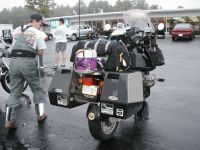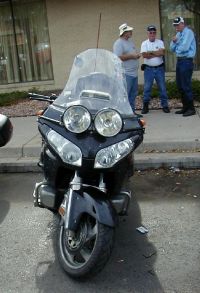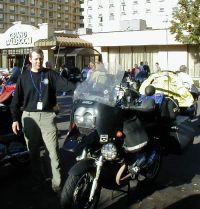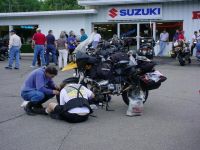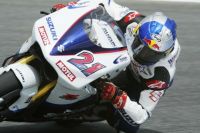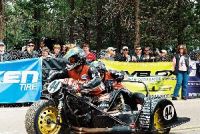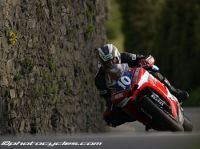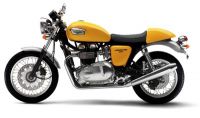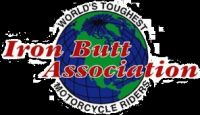The pain in Maine…
Author: site admin
Category: Other Forms Of Racing
…comes mainly because of rain!
The recurring theme for the 2005 Iron Butt Rally has been water. The 1st leg bonus list was dominated by lighthouses from coast to coast, along with various other H20 related items like dams, hot springs and water falls. Prophetically, the riders that headed east encountered torrential rains both going and returning, meaning they undoubtedly had more water in the first third of the rally than they really wanted. Added to that was the dampening of their enthusiasm when the points were tallied and those long haul east coast visitors found themselves languishing outside the top ten while those that took the relatively conservative west coast loop earned almost double the points while riding a 1,000 miles or less that the east coasters.
The water theme continued in the second leg with the majority of the bonuses being various lakes from the southern edge of Canada to the southern states of the US. The riders only had two and a half days to get from Denver, CO to Portland, Maine so it would be difficult for riders to pick up many bonuses. Its a long way from the Rocky Mountains to the Atlantic coast and it seems all that much longer when you’ve spent the past five days churning out the miles on a motorcycle. Every convenience store along I-70 was probably sold out of caffeine drinks and sugary snacks last weekend! The goal set for these riders was to leave Denver at 9am on Friday, grind their way through weekend traffic on the east coast while trying to pick a route that maximized their possible points but minimized their running late and arrive in Portland at 9am on Monday morning. For every minute after 9am that they arrived they would lose points from their total. If they arrived after 11am, they were automatically disqualified. This is a nerve racking time for endurance riders but made all that much more difficult when the weather in the northeast was…yes, you guessed it, wet. If they weren’t soaked from rain, they probably were from sweat.
For those that made the Maine checkpoint, another list of bonuses was handed out and at 11am EDT Monday morning the Star Traxx web site showed the riders were again on the road. While we don’t yet know what the leg 3 bonuses look like, it is guaranteed it will again have a hydro-theme…if not because of the locations they will be visiting then because of the weather being brought into the central states by hurricane Katrina. If there are any bonuses located in the south, then it will only be the brash or fool-hearty who go after them. Southern Florida is without power and with roads that are still shut down from storm damage, New Orleans is flooded and Mississippi is reeling after being hammered by storms and record amounts of rain. The riders still in the rally that have GPS units appear to have split the storm…some hauling butt west to get into the mid-west before the storm blocked their path while others concentrated on the east coast, presumably hoping to head west behind the storm.
Information has been particularly slow to trickle out of Iron Butt central this year and data about the specifics of the bonuses are non-existent. I think most of the people following the rally were surprised to see that some crazy bonuses weren’t available in leg 2 with the stipulation that the Maine bonus could be skipped. This means that the big rally winning bonuses are in the leg 3 packet. Now the rally truly boils down to an endurance test…those that still have some shreds of energy tucked away in their body and can still collect their thoughts enough to ride hard for four more days are going to win. For the rest, its just a matter of dragging their tired bodies and tired bikes back to Denver with the hope they have enough points to qualify for a finishers award.
Among those that are going for the big finish is my buddy Jeff Earls. After the leg #2 points were tallied, Jeff was in second place 3,500 points behind Jim Owens and around 2,000 points ahead of third place Eric Jewell. So far he’s racked up 7.125 miles on his BMW R1150GS and even a direct ride from Maine to Colorado would put him in the neighborhood of 10,500 miles for the rally…impressive considering that is 11 days of riding, much of which was done in the rain. Even more impressive, Jeff has no plans to take the straight path back to Denver. Instead, he is off chasing one of the race winning bonuses. He should be one of the favorites if his bike holds together, his body can take another few days of punishment and his brain can deal with the sleep depravation just a little longer.
I’m heading down Friday morning for the finish and hope to have a final Iron Butt Rally report early next week. In the meantime, try not to buy any soda from the Denver area stores…there may be a rally rider that needs it come Friday morning.
[image from the Blackfly photo gallery web site.]
